An Approach to Teachers’ opinion on the Assessment Process of Online Universities
DOI:
https://doi.org/10.37467/gka-revedu.v2.609Keywords:
Evaluation, Teaching, Training, Online, UniversityAbstract
The European Space of Higher Education (ESSE) has brought several structural changes into the Spanish space of Higher Education along some other changes in the University’s identity as an institution. Among the areas that have endured the deepest transformations, the process of evaluation is one. Thus, it is necessary to introduce changes in the way evaluation is done in the Spanish universities. These changes have to be undertaken within the framework of a formative perspective of the evaluation, integrating the concept of educational competences as well. In this article, the opinions and the abilities of a group of faculty members is analyzed. This group is compound by the staff of the Elementary Teaching Education Degree of the International University of La Rioja. In order to gather data, a survey was carried out during the second term of the 2012-2013 year-course.
Downloads
Global Statistics ℹ️
|
458
Views
|
239
Downloads
|
|
697
Total
|
|
References
Álvarez, B., González, C. & García, N. (2007). La motivación y los métodos de evaluación como variables fundamentales para estimular el aprendizaje autónomo. Revista de Docencia Universitaria (REDU) , 5(2). DOI: https://doi.org/10.4995/redu.2007.6275
Benito, A. & Cruz, A. (2011). Nuevas claves para la docencia universitaria en el Espacio Europeo de Educación Superior . Madrid: Narcea.
Delgado, A. M. & Oliver, R. (2003). Enseñanza del Derecho y tecnologías de la información y la comunicación [artículo en línea]. UOC. Consultado (29/05/2013) en http://www.uoc.edu/dt/20310/index.html.
Dorrego, E. (2006). Educación a Distancia y Evaluación del Aprendizaje. RED. Revista de Educación a Distancia , M6 (Número especial dedicado a la evaluación en entornos virtuales de aprendizaje). Consultado (02/06/2013) en http://www.um.es/ead/red/M6.
Navarro, A., López, J., Navarro, F. J. & Rojas B. (2009). ¿Sabemos enseñar y evaluar hoy? Consultado (10/01/2012) en http://www.eduinnova.es/monografias09/ENSENARYEVALUARHOY.pdf.
Onrubia, J. (2005). Aprender y enseñar en entornos virtuales: actividad conjunta, ayuda pedagógica y construcción del conocimiento. RED. Revista de Educación a Distancia , número monográfico II. Consultado (04/07/2013) en http://www.um.es/ead/red/M2.
Palma, M. (2011). Innovación y aprendizaje: Un nuevo modelo para la formación universitaria: ¿Por qué y para qué? Arbor 187(Extra_3): 77-81. DOI: https://doi.org/10.3989/arbor.2011.Extra-3n3130
Porto, M., García, M., & Navarro, E. (2013). ¿Qué evalúan los instrumentos de evaluación? Valoraciones de estudiantes. Arbor 189(760): a018 DOI: https://doi.org/10.3989/arbor.2013.760n2004
Rodríguez, G. & Ibarra, M.S. (2012). Reflexiones en torno a la competencia evaluadora del profesorado en la Educación Superior. Revista de Docencia Universitaria REDU. Número monográfico dedicado a las Competencias docentes en la Educación Superior, 10(2): 149-161. DOI: https://doi.org/10.4995/redu.2012.6101
Downloads
Published
How to Cite
Issue
Section
License
Those authors who publish in this journal accept the following terms:
-
Authors retain copyright.
-
Authors transfer to the journal the right of first publication. The journal also owns the publishing rights.
-
All published contents are governed by an Attribution-NoDerivatives 4.0 International License.
Access the informative version and legal text of the license. By virtue of this, third parties are allowed to use what is published as long as they mention the authorship of the work and the first publication in this journal. If you transform the material, you may not distribute the modified work. -
Authors may make other independent and additional contractual arrangements for non-exclusive distribution of the version of the article published in this journal (e.g., inclusion in an institutional repository or publication in a book) as long as they clearly indicate that the work was first published in this journal.
- Authors are allowed and recommended to publish their work on the Internet (for example on institutional and personal websites), following the publication of, and referencing the journal, as this could lead to constructive exchanges and a more extensive and quick circulation of published works (see The Effect of Open Access).













